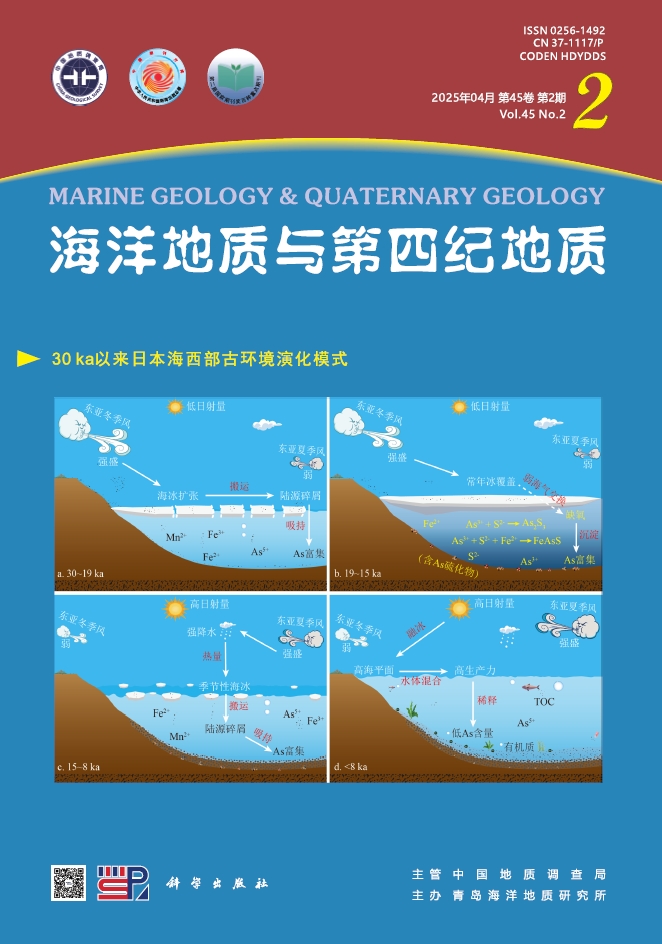| [1] |
Eglinton T I, Eglinton G. Molecular proxies for paleoclimatology[J]. Earth and Planetary Science Letters, 2008,275(1-2):1-16.
Google Scholar
|
| [2] |
Bianchi T S, Canuel E A. Chemical Biomarkers in Aquatic Ecosystems[M]. Princeton:Princeton University Press, 2011:396.
Google Scholar
|
| [3] |
谢树成, 殷鸿福, 史晓颖, 等. 地球生物学:生命与地球环境的相互作用和协同演化[M]. 北京:科学出版社, 2011:345.[XIE Shucheng, YIN Hongfu, SHI Xiaoying, et al. Geobiology:The Intercation and Synergetic Evolvement Between Life and Earth Environment[M]. Beijing:Science Press, 2011:345.]
Google Scholar
|
| [4] |
谢树成, Evershed R P. 泥炭分子化石记录气候变迁和生物演替的信息[J]. 科学通报, 2001,46(10):863-866.
Google Scholar
[XIE Shucheng, Evershed R P. Peat molecular fossils recording paleoclimatic change and organism replacement[J]. Chinese Science Bulletin, 2001,46(10):863-866.]
Google Scholar
|
| [5] |
Burdige D J. Geochemistry of Marine Sediments[M]. Princeton:Princeton University Press, 2007:609.
Google Scholar
|
| [6] |
赵京涛, 李军, 常凤鸣, 等. 西太平洋边缘MIS6期以来钙质超微化石的氧同位素记录及其古海洋学意义[J]. 海洋地质与第四纪地质, 2010,30(5):75-82.
Google Scholar
[ZHAO Jingtao, LI Jun, CHANG Fengming, et al. Oxygen isotope records of calcareous nannofossils since MIS6 from the marginal area of west Pacific[J]. Marine Geology and Quaternary Geology, 2010,30(5):75-82.]
Google Scholar
|
| [7] |
Klemm V, Levasseur S, Frank M, et al. Osmium isotope stratigraphy of a marine ferromanganese crust[J]. Earth and Planetary Science Letters, 2005,238(1-2):42-48.
Google Scholar
|
| [8] |
Cowen J P, DeCarlo E H, McGee D L. Calcareous nannofossil biostratigraphic dating of a ferromanganese crust from Schumann Seamount[J]. Marine Geology, 1993,115(34):289-306.
Google Scholar
|
| [9] |
苏新, 马维林, 程振波. 中太平洋海山区富钴结壳的钙质超微化石地层学研究[J]. 地球科学, 2004,29(2):141-147.
Google Scholar
[SU Xin, MA Weilin, CHENG Zhenbo. Calcareous nannofossil biostratigraphy for Co-rich ferromanganese crusts from central Pacific seamounts[J]. Earth Science, 2004, 29(2):141-147.]
Google Scholar
|
| [10] |
潘家华, 张静, 刘淑琴, 等. 西北太平洋富钴结壳的钙质超微化石地层学研究及意义[J]. 地球学报, 2007,28(5):411-417.
Google Scholar
[PAN Jiahua, ZHANG Jing, LIU Shuqin, et al. Calcareous nannofossil biostratigraphy of Co-rich crusts from northwestern Pacific and its significance[J]. Acta Geoscientica Sinica, 2007,28(5):411-417]
Google Scholar
|
| [11] |
Pulyaeva I A, Hein J R. Paleoceanographic Conditions During the Formation of Fe-Mn Crusts from the Pacific Ocean:Biostratigraphic and Compositional Evidence[R]. Gelendzhik, Russia:39th Underwater Mining Institute, 2010.
Google Scholar
|
| [12] |
Bramlette M N, Riedel W R. Stratigraphic value of discoasters and some other microfossils related to recent coccolithophores[J]. Journal of Paleontology, 1954,28(4):385-403.
Google Scholar
|
| [13] |
Bramlette M N, Wilcoxon J A. Middle Tertiary calcareous nannoplankton of the Cipero section, Trinidad, W.I.[J]. Tulane Studies of Geology, 1967,5(3):93-131.
Google Scholar
|
| [14] |
Raffi I, Backman J, Fornaciari E, et al. A review of calcareous nannofossil astrobiochronology encompassing the past 25 million years[J]. Quaternary Science Reviews, 2006,25(2324):3113-3137.
Google Scholar
|
| [15] |
Bown P R. Calcareous Nannofossil Biostratigraphy[M]. Netherlands:Springer, 1998:315.
Google Scholar
|
| [16] |
Bolli H M, Saunders J B, Perch-Nielsen K. Plankton Stratigraphy:Volume 1, Planktic Foraminifera, Calcareous Nannofossils and Calpionellids[M]. Cambridge University Press, 1989.
Google Scholar
|
| [17] |
Berggren W A, Kent D V, Swisher C C, et al. A revised Cenozoic geochronology and chronostratigraphy[M]//BERGGREN W A. Geochronology, Time Scales, and Global Stratigraphic Correlation. Tulsa, Okla; Society for Sedimentary Geology. 1995:129-212.
Google Scholar
|
| [18] |
Martini E. Standard Tertiary and Quaternary calcareous nannoplankton zonation[C]//Proceedings of the Second Planktonic Conference. 1970.
Google Scholar
|
| [19] |
Zhang M, Sun X, Xue T, et al. Hydrocarbons in ferromanganese crusts from Pacific seamounts and their implications for the genesis[J]. Acta Petrologica Sinica, 2007,23(11):3026-3036.
Google Scholar
|
| [20] |
Weber T S, Deutsch C. Ocean nutrient ratios governed by plankton biogeography[J]. Nature, 2010,467(7315):550-554.
Google Scholar
|
| [21] |
Volkman J K. A review of sterol markers for marine and terrigenous organic matter[J]. Organic Geochemistry, 1986,9(2):83-99.
Google Scholar
|
| [22] |
Blumer M, Guillard R R L, Chase T. Hydrocarbons of marine phytoplankton[J]. Marine Biology, 1971,8(3):183-189.
Google Scholar
|
| [23] |
Rielley G, Collier R J, Jones D M, et al. The biogeochemistry of Ellesmere Lake, U.K.-I:source correlation of leaf wax inputs to the sedimentary lipid record[J]. Organic Geochemistry, 1991,17(6):901-912.
Google Scholar
|
| [24] |
Ragueneau O, Tréguer P. Determination of biogenic silica in coastal waters:applicability and limits of the alkaline digestion method[J]. Marine Chemistry, 1994,45(12):43-51.
Google Scholar
|
| [25] |
Weber T, Deutsch C. Oceanic nitrogen reservoir regulated by plankton diversity and ocean circulation[J]. Nature, 2012,489(7416):419-422.
Google Scholar
|
| [26] |
Deutsch C, Weber T. Nutrient ratios as a tracer and driver of ocean biogeochemistry[J]. Annual Review of Marine Science, 2012,4(1):113-141.
Google Scholar
|
| [27] |
Wen H, Qiu Y, Yao L, et al. Organic geochemistry and biomarkers of some Lower Cambrian high-selenium formations in China[J]. Geochimica, 2000,29(1):28-35.
Google Scholar
|
| [28] |
Peters K E, Walters C C, Moldowan J M. The Biomarker Guide:Volume 2, Biomarkers and Isotopes in Petroleum Systems and Earth History[M]. Cambridge:Cambridge University Press, 2007:704.
Google Scholar
|
| [29] |
Powell T G. Pristane/phytane ratio as environmental indicator[J]. Nature, 1988,333(6174):604.
Google Scholar
|
| [30] |
Volkman J K, Alexander R, Kagi R I, et al. Biodegradation of aromatic hydrocarbons in crude oils from the Barrow Sub-basin of Western Australia[J]. Organic Geochemistry, 1984,6(0):619-632.
Google Scholar
|
| [31] |
许东禹, 姚德, 梁宏峰. 多金属结核形成的古海洋环境[M]. 北京:地质出版社, 1994:111.[XU Dongyu, YAO De, LIANG Hongfeng. The Ancient Marine Environment During The Formation of Polymetallic Nodules[M]. Beijing:Geological Publishing House, 1994:111.]
Google Scholar
|
| [32] |
Volkman J K. Lipid Markers for Marine Organic Matter[M]//Volkman J K. Marine Organic Matter:Biomarkers, Isotopes and DNA. Springer Berlin/Heidelberg, 2006:27-70.
Google Scholar
|
| [33] |
Nytoft H P, Bojesen-Koefoed J A, Christiansen FG. C26 and C28-C34 28-norhopanes in sediments and petroleum[J]. Organic Geochemistry, 2000,31(1):25-39.
Google Scholar
|






 DownLoad:
DownLoad: